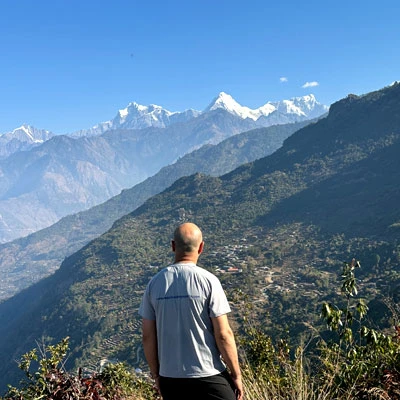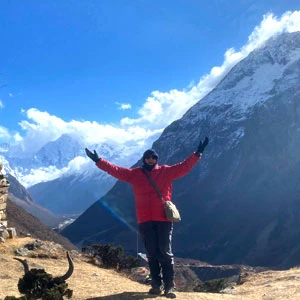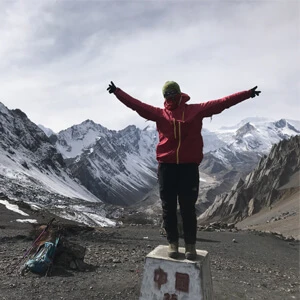Why Do You Need Permits For The Gokyo Valley Trek?
Trekking in Nepal, especially in iconic regions like the Gokyo Valley, is regulated by a structured permit system implemented by the government. These regulations serve several essential purposes that benefit both trekkers and the country.
Nepal’s trekking permits are designed to manage the growing number of foreign travelers entering remote areas. It ensures safety, maintains records, and generates revenue for conservation and local development projects.
Similarly, these permits ensure the protection of conservation areas, particularly the Sagarmatha National Park, which is a UNESCO World Heritage Site. They also help authorities monitor and limit human impact on the region.
In addition, the Khumbu Pasang Lhamu Rural Municipality Permit enables local governance bodies to regulate movement within the region and track tourist numbers. Altogether, the permits help support the local communities and conservation efforts.
A portion of the revenue collected from permits goes directly into community development projects, such as building schools, maintaining trails, improving healthcare facilities, and preserving cultural heritage. When you pay for your permits, you are actively contributing to the livelihoods of the Sherpa people and helping sustain the environment you are there to explore.
Mandatory Permits Required For The Gokyo Valley Trek
To trek to Gokyo Valley, you must obtain two mandatory permits: the Sagarmatha National Park Entry Permit and the Khumbu Pasang Lhamu Rural Municipality Permit. These permits are essential for legal entry, conservation support, and local governance in the Everest region.
Sagarmatha National Park Entry Permit
The Sagarmatha National Park Entry Permit is one of the two essential documents for the Gokyo Valley. This permit grants you legal access to the Sagarmatha National Park, a UNESCO World Heritage Site and home to some of the world’s highest peaks.
This particular permit will cost you as below.
NPR 3,000 per person for foreign nationals
NPR 1,500 per person for SAARC nationals
Where To Obtain The Permit?
You can obtain the Sagarmatha National Park Entry Permit in two primary locations:
Nepal Tourism Board Office in Kathmandu: It is ideal if you prefer to arrange all documents before traveling to the mountains.
Monjo Checkpoint: It is located on the trail just before entering the national park. It is a convenient option if you begin your trek without pre-arranged permits.
Well, NTE recommends that you get the permit in Kathmandu to avoid queues or potential delays on the trail. This permit is non-negotiable and frequently checked at various checkpoints along the route, so keeping it handy is crucial throughout your trek.
Khumbu Pasang Lhamu Rural Municipality Permit
The Khumbu Pasang Lhamu Rural Municipality Permit is a mandatory local government entry fee for anyone trekking in the Khumbu region, including the Gokyo Valley. It was introduced in 2018, and this permit has replaced the previously required TIMS (Trekkers’ Information Management System) card.
It was established by the local rural municipality to manage and support the increasing number of trekkers entering the area. The funds collected through it are used by the rural municipality to improve trekking routes, manage waste, support healthcare and education in remote villages, and enhance the overall trekking experience in the Everest region.
Unlike national-level permits, this one is managed and utilized by the local community.
The cost of this particular permit is NPR 3,000 per person (approx. USD 25 to 30 depending on exchange rates). This is a one-time fee regardless of the duration of your trek in the Khumbu area.
Where Can You Obtain This Permit?
You can purchase the Khumbu Pasang Lhamu Permit at two main points:
- Lukla: Right after you land at Tenzing-Hillary Airport, there is a checkpoint where you can obtain the permit before proceeding further.
- Monjo: If you bypass the Lukla checkpoint or if you are entering from another access point, Monjo (just before entering Sagarmatha National Park) is another place to get the permit.
Note: You cannot obtain this permit in Kathmandu or online, so it is crucial to factor this into your travel plans.
Where And How To Get The Gokyo Valley Trek Permits
Obtaining the required permits for the Gokyo Valley Trek is a straightforward process. You can get both the Sagarmatha National Park Entry Permit and the Khumbu Pasang Lhamu Rural Municipality Permit at various official locations along your route, but the most efficient option is to arrange them in Kathmandu before you head to the mountains.
In Kathmandu, you can visit the Nepal Tourism Board Office in Bhrikutimandap. Likewise, if you need updated trekking information, permit queries, and agency support, then you can visit the site of TAAN (Trekking Agencies' Association of Nepal).
Now, if you are visiting the office for permits, you should avoid going on weekends and also check if there is any public holiday. Altogether, if you don't have time to get your permits in Kathmandu, you can obtain both permits on the trail.
Documents Required For The Permits
To apply for either permit, you will need:
- A valid passport with a current Nepali visa
- 2 to 4 passport-size photos
- A detailed trekking itinerary, especially if applying through an agency
- Proof of travel insurance
If you are trekking independently, you can still apply for the permits yourself without using a guide, as long as you have the required documents.
Permit Fee Summary Table
Permit Type | Cost | Where To Get |
Sagarmatha National Park Permit | NPR 3,000 per person (approx. USD 25 to 30 depending on exchange rates) | Kathmandu or Monjo |
Khumbu Pasang Lhamu Rural Municipality Permit | NPR 3,000 per person (approx. USD 25 to 30 depending on exchange rates) | Lukla or Monjo |
Consequences of Not Having Required Permits During The Gokyo Valley Trek
If you fail to show valid permits at designated checkpoints, such as Monjo or Lukla, local authorities or park officials can immediately stop your trek. In such cases, you may be forced to return to the nearest town to obtain the required documents. In more severe situations, you could face a fine or even be barred from continuing your trek altogether.
Even if you make the trek without permits, in case of an immediate emergency, your insurance claim might fall off. If you get involved in any accidents, your travel insurance provider may reject your claim if you haven't complied with the local trekking regulations.
Lastly, the funds from these permits are used for the betterment of the local community and region; however, bypassing them will harm the sustainability of the region. In short, trekking without permits is not worth the risk.
Gokyo Valley Permit Application Tips
- Avoid potential delays by getting your permits at the Nepal Tourism Board office in Kathmandu before flying to Lukla.
- Keep at least 4 to 6 passport-size photos with you.
- Make sure your passport is valid for at least 6 months and has your valid Nepal visa stamped before applying.
- Keep scanned or photographed copies of your permits, passport, insurance, and visa on your phone or cloud storage.
- Prepare a rough trekking itinerary and submit it while applying for the permit.
- If you are planning to get the permits in Lukla or Monjo, make sure that you are carrying enough cash.
Gokyo Valley Trekking Checklist
Clothing
- Moisture-wicking thermal tops and bottoms
- Lightweight t-shirts (quick-dry)
- Fleece or down jacket
- Insulated vest (optional)
- Waterproof and windproof shell jacket
- Waterproof trekking pants
- Trekking trousers (2 to 3 pairs)
- Thermal leggings (for cold nights
- Wool or fleece hat/beanie
- Sun hat or cap
- UV-protection sunglasses
- Buff or neck gaiter
- Warm gloves
Footwear
- High-quality trekking boots (broken-in)
- Comfortable camp shoes or sandals
- Wool or synthetic trekking socks (4 to 6 pairs)
Gear & Equipment
- 35 to 45L daypack with rain cover
- Duffel bag or backpack (for porter, if using one)
- Four-season sleeping bag (rated -10°C or lower)
- Adjustable and shock-absorbent trekking poles
- Water bottles (1L x 2)
- Water purification tablets or steriPEN
- Energy bars, trail mix, or snacks
Toiletries & Personal Items
- Biodegradable soap and shampoo
- Toothbrush and toothpaste
- Quick-dry towel
- Wet wipes and hand sanitizer
- Lip balm with SPF
- Sunscreen (SPF 50+)
- Toilet paper or tissue packs
- Menstrual hygiene products (if needed)
- Basic first aid kit, including personal medications
- Headlamp with extra batteries
- Power bank
Conclusion
Trekking through the breathtaking Gokyo Valley is an unforgettable Himalayan experience, but it requires the right paperwork to ensure a smooth and legal journey. To explore this high-altitude wonderland, you must secure two essential permits: the Sagarmatha National Park Entry Permit and the Khumbu Pasang Lhamu Rural Municipality Permit. Skipping them can lead to fines, denied access, or even being turned back mid-trek.
Before you hit the trail, prepare all necessary documents in advance: a valid passport with a visa, a few passport-size photos, your trekking itinerary, and proof of insurance if required. It's always wise to obtain your permits from official offices in Kathmandu to avoid last-minute complications. If you prefer a hassle-free process, contact Nepal Trekking Experts to help handle all logistics for you.
FAQs
What permits do I need for the Gokyo Valley Trek?
You need the Sagarmatha National Park Entry Permit and the Khumbu Pasang Lhamu Rural Municipality Permit.
Do I still need a TIMS card for this trek?
No, the TIMS card is no longer required for the Gokyo Valley or other treks in the Khumbu region.
How much do the permits cost in total?
The permits cost approximately NPR 5,000 per person for both.
Where can I get the permits?
You can get them in Kathmandu at the Nepal Tourism Board or at entry points like Lukla and Monjo.
What documents should I bring to apply?
You will need a valid passport, visa, 2 to 4 passport-size photos, and your trekking itinerary.
Can I get the permits online?
No, permits must be obtained in person or through a registered trekking agency.
Are permits checked during the trek?
Yes, there are multiple checkpoints where your permits will be verified.
What happens if I trek without permits?
You may be fined, stopped from continuing, or denied access to certain areas.
Can I get permits on the same day of travel?
Yes, if you go during office hours, but it’s best to get them a day in advance to avoid delays.
Should I use a trekking agency to handle permits?
Yes, agencies like Nepal Trekking Experts can arrange everything and save you time.







